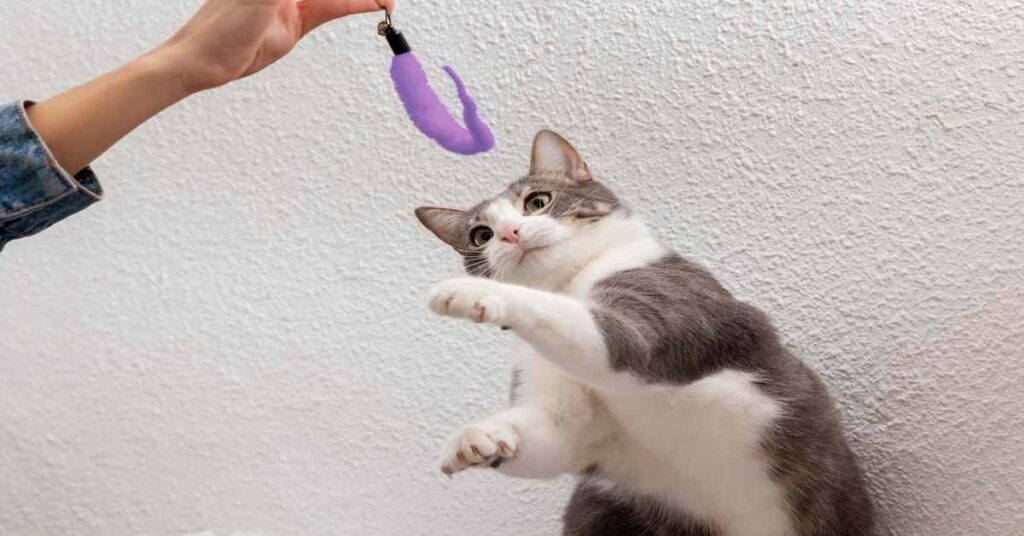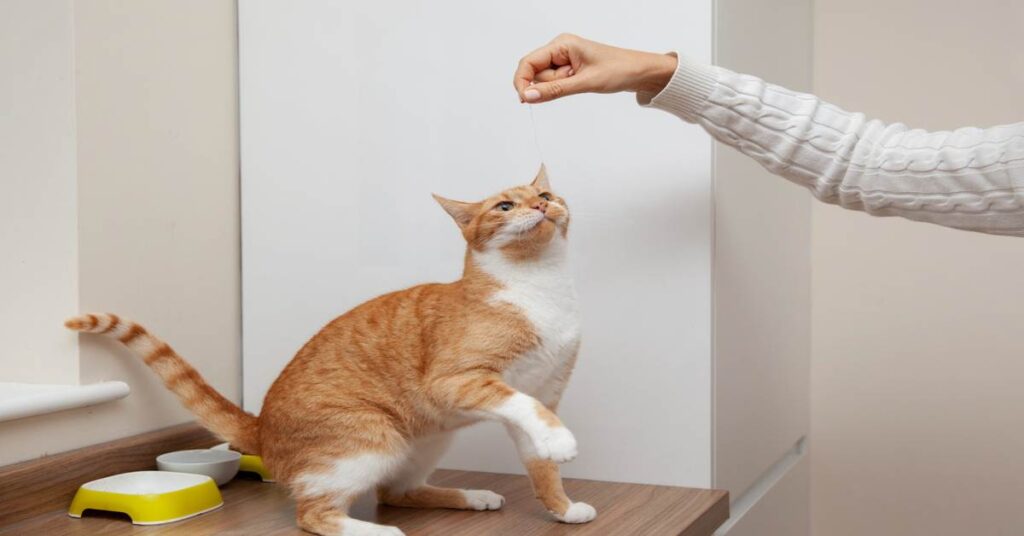How to train a cat? Training a cat may seem daunting, but it’s possible with patience and understanding. Cats, known for independence, can still learn and bond with you.
In this guide, we’ll explore effective strategies for training your cat. Positive reinforcement, consistency, and patience are key from basic obedience to behavior modification.
Understanding your cat’s behaviors and motivations helps tailor your training approach. With dedication, you can build a strong bond while instilling good manners.
Ready to know how to train a cat? Let’s explore feline behavior and unlock your cat’s potential together.

Reasons why training cats is important
- Establishing Boundaries: Training helps cats understand what behaviors are acceptable and what are not. This includes using the litter box, scratching posts instead of furniture, and not jumping onto countertops or tables.
- Safety: Training can prevent dangerous behaviors like darting out of open doors or chewing on electrical cords. Teaching cats to come when called or stay indoors can help keep them safe from accidents and predators.
- Improved Bonding: Training sessions provide opportunities for bonding between cats and their owners. Positive interactions during training strengthen the relationship and build trust.
- Reducing Stress: Well-trained cats are often more confident and less stressed because they know what to expect from their environment and their owners. This can lead to a happier and healthier cat overall.
- Medical Care: Training cats to tolerate grooming, nail trimming, and veterinary visits makes it easier to provide necessary medical care throughout their lives. This reduces stress for both the cat and the owner during these procedures.
- Behavioral Issues: Training can help address and prevent behavioral issues such as aggression, excessive meowing, or destructive scratching. Redirecting these behaviors through training can lead to a more harmonious household.
- Enrichment: Training provides mental stimulation for cats, keeping them engaged and preventing boredom. This is especially important for indoor cats who may not have as many opportunities for exploration and stimulation.
- Socialization: Training can help socialize cats to be comfortable around people, other animals, and new environments. This is important for their overall well-being and can prevent fear or aggression towards strangers.

Before start training
Before starting training with your cat, it’s important to consider a few key points:
- Understand Your Cat: Take the time to observe your cat’s behavior, personality, and preferences. Understanding what motivates your cat will help you tailor your training approach to their needs.
- Establish Trust: Building trust with your cat is essential for successful training. Spend quality time bonding with your cat through gentle petting, play, and positive interactions.
- Set Realistic Expectations: Cats have their own pace and may not respond immediately to training. Be patient and realistic about what you can achieve, focusing on gradual progress rather than immediate results.
- Create a Positive Environment: Ensure that the training environment is free from distractions and conducive to learning. Choose a quiet space where your cat feels comfortable and relaxed.
- Gather Necessary Supplies: Depending on the type of training you plan to do, gather any necessary supplies such as treats, toys, clickers, or scratching posts.
- Consult with a Professional: If you’re unsure about how to train your cat or if you’re dealing with specific behavioral issues, consider seeking advice from a professional animal behaviorist or veterinarian.
How to train a cat?

Get the necessary tools
The necessary tools for training your cat may vary depending on the specific behaviors you’re working on and your training approach. However, some common tools and supplies that can be helpful for cat training include:
- Treats: High-value treats that your cat loves can be used as rewards for desired behaviors during training sessions.
- Clicker: A clicker device can be used in conjunction with treats to mark desired behaviors with a distinct sound, making it easier for your cat to understand what they’re being rewarded for.
- Toys: Interactive toys can be used to engage your cat during training sessions and to redirect their energy towards appropriate behaviors.
- Scratching Posts: Providing scratching posts or pads can help redirect your cat’s scratching behavior away from furniture and other undesirable surfaces.
- Litter Box: If you’re working on litter box training, having a clean and appropriately sized litter box in a quiet, accessible location is essential.
- Harness and Leash: If you’re training your cat to walk on a leash, a harness specifically designed for cats and a lightweight leash are necessary tools.
- Training Books or Resources: Educate yourself on cat behavior and training techniques by reading books, watching videos, or consulting reputable online resources.
- Patience and Persistence: While not physical tools, patience and persistence are essential qualities for successful cat training. Consistency and positive reinforcement are key to effectively shaping your cat’s behavior over time.
10 training tips
- Use Positive Reinforcement: Cats respond well to positive reinforcement techniques. Reward desired behaviors with treats, praise, or playtime to encourage repetition.
- Be Patient and Consistent: Cats may take time to learn new behaviors, so be patient and consistent in your training efforts. Stick to a regular schedule and use the same cues and rewards consistently.
- Keep Training Sessions Short: Cats have short attention spans, so keep training sessions brief, typically around 5-10 minutes at a time. Multiple short sessions throughout the day can be more effective than one long session.
- Focus on One Behavior at a Time: Trying to teach too many behaviors at once can be overwhelming for your cat. Focus on one behavior at a time until they’ve mastered it before moving on to the next.
More tips
- Start with Basic Commands: Begin with simple commands like “sit,” “stay,” or “come.” Once your cat has mastered these basic commands, you can move on to more advanced behaviors.
- Use Clicker Training: Clicker training involves using a clicker device to mark desired behaviors, followed by a reward. This technique helps cats understand exactly which behavior is being rewarded.
- Redirect Undesirable Behavior: Instead of punishing your cat for unwanted behaviors, redirect their attention to more appropriate activities. For example, if your cat is scratching the furniture, gently redirect them to a scratching post and reward them for using it.
- Be Observant: Pay attention to your cat’s body language and reactions during training sessions. If they seem stressed or uninterested, take a break and try again later.
- End on a Positive Note: Always end training sessions on a positive note, even if progress is slow. This will keep your cat engaged and motivated for future training sessions.
- Seek Professional Help if Needed: If you’re struggling with training or dealing with behavioral issues, don’t hesitate to seek advice from a professional animal behaviorist or veterinarian.

How to train a cat on tricks
Teaching your cat tricks can be a fun and rewarding way to bond with your feline companion. Here are some popular tricks you can teach your cat:
- Sit: Start by holding a treat above your cat’s head and slowly moving it back towards their tail. As your cat follows the treat with their head, their bottom should naturally lower to the ground. When they sit, immediately give them the treat and praise them.
- Shake Hands (or High Five): Hold a treat in your hand and offer it to your cat. When they reach out with their paw to touch your hand, say “shake” or “high five” and give them the treat. Repeat this until they consistently offer their paw on command.
- Come When Called: Begin by calling your cat’s name in a cheerful tone and rewarding them with a treat or praise when they come to you. Gradually increase the distance between you and your cat when calling them, always rewarding them for coming to you.
- Spin: Hold a treat in front of your cat’s nose and slowly move it in a circular motion. As your cat follows the treat with their nose, they should naturally turn in a circle. Once they complete the spin, give them the treat and praise them.
Other tricks
- Jump Through a Hoop: Hold a hula hoop or small hoop in front of your cat and encourage them to walk through it by holding a treat on the other side. Gradually raise the hoop higher off the ground as your cat becomes more comfortable jumping through it.
- Fetch: Start by tossing a small toy or crumpled piece of paper a short distance away from your cat. Encourage them to retrieve the toy by offering treats and praise when they bring it back to you. Repeat this process, gradually increasing the distance your cat retrieves the toy.
- Roll Over: Begin by getting your cat to lie down on their side. Hold a treat close to their nose and slowly move it in a circular motion towards their back, encouraging them to roll over onto their other side. When they complete the roll, give them the treat and praise them.
- Play Dead: Start by getting your cat to lie down on their side. Hold a treat close to their nose and slowly move it away from them towards the ground. As your cat follows the treat with their head, they should naturally lie flat on their side. When they are lying down completely, give them the treat and praise them.
Read more facts!
How to train a cat? FaQs
How long do cats need to be trained?
Cat training duration varies based on factors like age, temperament, and past experiences. Basic commands and simple tricks can take a few weeks to months to teach. More complex behaviors may need ongoing training over time. Training is a continuous process even after behaviors are learned. Refreshers and reinforcement may be necessary. Cats can continue to learn and develop new skills throughout their lives.
How often should I train my cat?
You can train your cat several times a day for short sessions. Aim for around 5-10 minutes per session. Multiple short sessions throughout the day are more effective than one long session. Be consistent with training to reinforce learning. Adjust training frequency based on your cat’s attention span and responsiveness.
How do you train a cat to stay?
To train a cat to stay, follow these steps:
- Start in a quiet, distraction-free environment.
- Command your cat to “sit” or “stay” while in a sitting position.
- Hold your palm out towards your cat’s face, like a stop signal.
- Step back slightly and wait a moment.
- If your cat stays in place, reward them with a treat and praise.
- Gradually increase the distance and duration of the stay command.
- If your cat breaks the stay, calmly return them to the starting position and try again.
- Practice consistently and gradually increase distractions.
- Reward your cat for successfully staying in place, even for short durations.
How are cats easier to train?
Cats can be easier to train due to their independent nature. They are intelligent and quickly learn cause and effect. Many training exercises tap into their natural behaviors. Cats thrive on routine, making consistency important. Training sessions also provide bonding opportunities.




